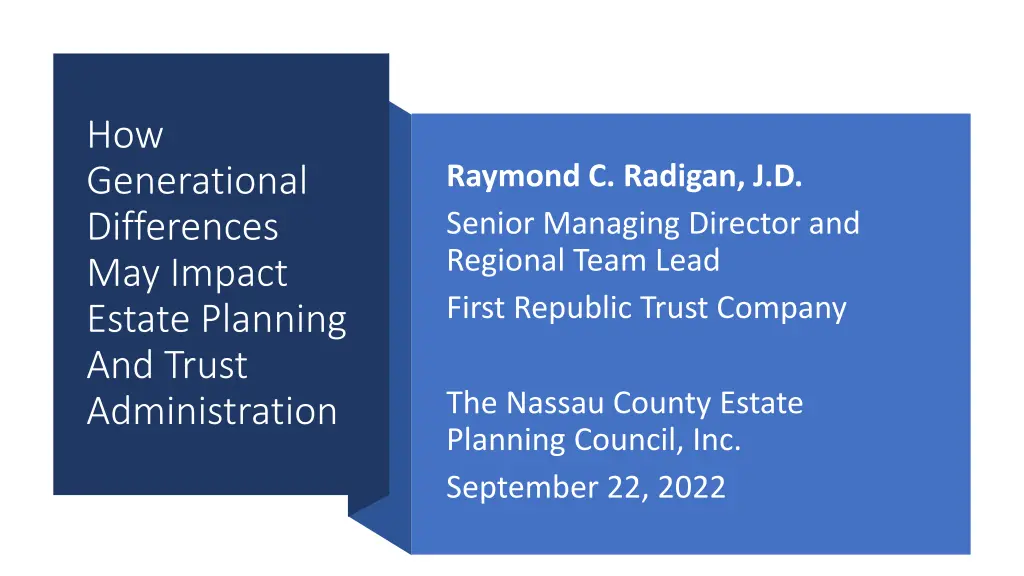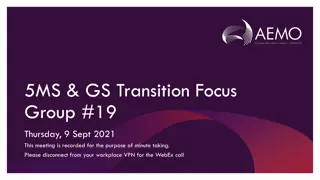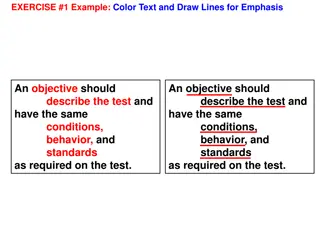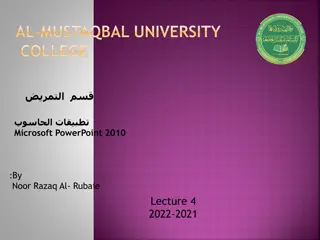
Generational Impact on Estate Planning & Trust Administration
Explore how generational differences influence estate planning and trust administration, analyzing characteristics from the Greatest Generation to Generation Alpha and discussing current trends and the evolution of trust over generations.
Download Presentation

Please find below an Image/Link to download the presentation.
The content on the website is provided AS IS for your information and personal use only. It may not be sold, licensed, or shared on other websites without obtaining consent from the author. If you encounter any issues during the download, it is possible that the publisher has removed the file from their server.
You are allowed to download the files provided on this website for personal or commercial use, subject to the condition that they are used lawfully. All files are the property of their respective owners.
The content on the website is provided AS IS for your information and personal use only. It may not be sold, licensed, or shared on other websites without obtaining consent from the author.
E N D
Presentation Transcript
How Generational Differences May Impact Estate Planning And Trust Administration Raymond C. Radigan, J.D. Senior Managing Director and Regional Team Lead First Republic Trust Company The Nassau County Estate Planning Council, Inc. September 22, 2022
How Generational Differences May Impact Estate Planning And Trust Administration Section I Generational Differences Discuss the general traits and characteristics of each generation from the Greatest Generation to Generation Alpha. Section II Current Trends Discuss modern social changes and technological advances and how they could affect Estate Planning and Trust Administration in current and future years. Section III Estate Planning and Trust Administration Today Review the evolution of the Trust Document and the Trust Experience over the generations. 2
SECTION I. GENERATIONAL DIFFERENCES 3
The Baby Boomers Generation Alpha The Greatest Generation (95 to 121) Millennials (26 to 41) (58 to 76) (0 to 9) List of Different Generations (ages in 2022) 1901 1927 1946 1964 1981 1996 2013 2025 1928 1945 1965 1980 1997 2012 Generation X (42 to 57) Generation Z (10 to 25) The Silent Generation (77 to 94) 4
Also known as the GI Generation Grew up in the Depression Many fought in World War II Fought for what was right as opposed to for selfish reasons Moralistic attitude toward the conflict Had personal responsibility, duty, honor and faith The Greatest Generation 1901 - 1927 5
Notable Members of the Greatest Generation John F. Kennedy Margaret Thatcher Ronald Reagan Rosa Parks Lucille Ball Mother Theresa Johnny Carson Queen Elizabeth II Jackie Robinson Nelson Mandela 6
Notable Living Members of the Greatest Generation Anthony Dominick Benedetto Janis Paige Melvin Kaminsky June Lockhart William Daniels Gina Lollobrigida Norman Lear Angela Lansbury Dick Van Dyke Glynis Johns Jimmy Carter Rosemary Harris 7
Also known as the Traditionalists About 20 million alive in 2022 Smaller population than the Greatest Generation and Baby Boomers Some were born and lived through the Depression Grew up expecting a hard life - endured sacrifice Rebuilt U.S. economy after World War II Thrifty, respectful, loyal and determined Tended to marry and have children at younger ages Silent because they did not protest, accepted government - McCarthy era The Silent Generation 1928 - 1945 8
Notable Members of the Silent Generation Paul McCartney Joan Rivers Bill Russell Diana Ross Willie Mays Barbra Streisand Martin Luther King Julie Andrews Colin Powell Anne Frank Bob Dylan Elizabeth Montgomery Muhammed Ali Billie Jean King 9
Booming births after World War II Preference for structure and discipline workaholics Lived through time of prosperity - absence of World War Country s wealthiest generation Retiring later than previous generations Represents about one-fifth of the population today Flower children, protest, civil rights, Vietnam, Kennedy and King assassinations and moon landing Strong interpersonal skills Had to adapt to advances in technology Baby Boomers 1946 - 1964 10
Notable Baby Boomers Madonna Bill Gates Angela Merkel Michael Jordan Maureen McCormick Ray Radigan Bruce Springsteen Oprah Winfrey Bill Clinton Princess Diana Barack Obama Charo 11
Often children of two working parents - the daycare generation Many value work/life balance - work smart, not hard Well educated, have appetite for continued learning Many are part of the Sandwich Generation - raising children and caring for aging parents Marrying later than previous generations Passion for charity Independent, self-sufficient, value autonomy Comfortable with technology Lived through many changes - MTV, AIDS, Disco, the fall of the Berlin Wall and the Soviet Union Generation X 1965 - 1980 12
Notable Members of Generation X Tyra Banks Charlie Sheen Jennifer Aniston Mike Tyson Tonya Harding Tiger Woods J.K. Rowling Tom Brady Liz Truss Elon Musk 13
Just starting careers and family Motivated by meaningful work Largest generation in the U.S. workforce Prefer to collaborate (vs. top down) Want voices to be heard Marrying and having children later than previous generations Move more often - many rent vs. own Less wealth than previous generations Digital natives - grew up on the internet Greater use of digital assets Millennials 1981 - 1996 14
Notable Millennials LeBron James Serena Williams Mark Zuckerberg Malala Yousafzai Stephen Curry Beyonce Pete Buttigieg Natalie Portman Michael Phelps Lady Gaga 15
Value social responsibility and diversity Expect to work with modern technology Expect to marry later than previous generations Less likely to be religious Less time in shopping malls Less personal interaction More concerned with climate crisis More focused on mental health than previous generations Greater use of digital assets Generation Z 1997 - 2012 16
Trevor Lawrence Olivia Rodrigo Billie Eilish Justin Herbert Amandla Stenberg Naomi Osaka Greta Thunberg Notable Members of Generation Z 17
Generation Alpha 2013 - 2025 Youngest generation More diverse family dynamics Higher racial diversity Possible higher economic inequality 18
Notable Members of Generation Alpha Prince George Carter Radigan Brody Radigan Dak Zelazny 19
1950 68.14 1960 69.84 1970 70.78 1980 73.70 1990 75.19 2000 76.75 2010 78.49 2020 76.99 2021 76.60 Historical Life Expectancy Data - US 21
Life expectancy has doubled over the past 150 years Over 85 years old is the fastest growing segment of the population Women born in South Korea in 2030 are expected to have an average life expectancy of 90 years One third of babies born in the UK in 2013 are expected to live to 100 The estimated US centenarian population in 1830 was 539 (75,000 today) The estimated world centenarian population was 95,000 in 1995, 451,000 in 2015 and will grow to 3.7 million in 2050 Interesting Facts About Longevity 22
Worldwide population of dementia is 46 million By 2050, the expected worldwide population of dementia will be 130 million A new case of dementia is diagnosed every 3 seconds Estimated that 5% - 8% of those over 65 have dementia About 47% of those over 85 have dementia An estimated 5.8 million Americans have dementia today and an estimate of 14 million will have dementia in 2060 Facts About Dementia 23
Generations That Report Mental Health Is Good or Excellent (percentage) Baby Boomer Generation X Millennials Generation Z 70% 51% 56% 45% Source: American Psychological Association 24
Higher levels of stigma surrounding mental illness or depression in older adults Pandemic has caused a significant increase in depression in all generations Generation Z has reported higher rates of depression than previous generations but are more likely to seek help Anxious and depressed youth are increasingly given multiple and powerful pharmaceuticals 37% of Generation Z has sought help from a mental health professional The right treatment might include therapy and proper medication Other Factors About Mental Illness 25
Maximum Monthly Social Security Benefit in 2022 AGE 62 66 70 $2,364 $3,240 $4,194 26
More than $1 trillion of Social Security benefits were paid to 65 million recipients in 2020 Since 2010, the system brings in less revenue than pays out in benefits, with the shortfall paid from reserves Under the current laws, the funds for Social Security will be exhausted in 2034 - if so, benefits must be cut by 22% The Current Status of Social Security Source: 2021 Social Security Trustee s Report 27
Possible Ways to Save Social Security Increase the retirement age Increase the payroll tax (6.2%) Increase the cap of income subject to the payroll tax If the payroll cap is eliminated, it is estimated that this would reduce between one-half to two-thirds of the shortfall 28
SECTION III. ESTATE PLANNING AND TRUST ADMINISTRATION TODAY 29
Evolution of the Trust Document Old Use of interested trustee - family member Invasions for health, maintenance, education and support Distributions at age attainments No power to remove the trustee Family not involved in trust administration New Use of disinterested trustee Complete discretion to invade income and principal to maximize asset protection Fewer outright distributions at age attainments, or trustee s power to withhold that distribution, if need be Power to remove the trustee Family named as co-trustees More flexibility- trust protector, modification by state law, non judicial settlements, decant Address ownership of digital assets Increase use of Directed Trusts Incentive Trusts 30
Evolution of the Trust Experience Old - Negative Current - Positive Proactive communication Beneficiaries are involved Better investment performance and more elaborate asset allocation Power to remove the Trustee Incentive Trusts More flexibility Lack of communication Beneficiaries not involved Lackluster investment performance No power to remove the trustee Lack of incentives Lack of flexibility 31
Lifetime gifts - take advantage of the Federal gift tax exemption Transfers at death Retain more control and maximize asset protection Provide incentives Succession planning Plan for possible future incapacity Avoid probate Increase in depression Special needs Use of Trusts More Commonplace 32
Name alternate beneficiaries if the primary beneficiaries are deceased Appoint successor fiduciaries Empower beneficiaries to make changes - power of appointment, power to replace the Trustee Empower Trustees to make changes Designate a Trust Protector Consider decanting, when appropriate Give the Grantor the power to substitute assets Incorporating Flexibility into the Estate Plan New York does not have a statute recognizing the Trust Protector or the Non-Judicial Settlement Agreement. 33
Using a General Power of Appointment to Obtain a Step Up in Basis - Example A Trust is established and includes a farm that was purchased for $200,000. The farm is now worth $3 million due to potential development rights. X, the beneficiary, has a general power of appointment over the farm property. X owns other assets worth $2 million and dies in 2022. The farm is included in X s estate , even though X did not exercise the power of appointment and the farm goes to others pursuant to the terms of the Trust. Since the total value of X s estate is $5 million, the estate will not owe any New York or Federal estate taxes. The new cost basis of the farm is now $3 million. 34
Using a Limited Power of Appointment to Change the Distribution of Trust Assets - Example Grantor and spouse have two children. Grantor dies and creates a Trust for the benefit of the surviving spouse. The surviving spouse has a limited power of appointment where at death, he or she has the power to appoint the remaining property, outright or in further trust, for either of their two children. Otherwise, the trust assets will be divided equally and in further trust for each of their two children. Since the creation of the Trust, the first child has become extremely wealthy while the second child is working at a charitable organization. The surviving spouse may decide to direct that all or a larger portion of the remaining assets be held in trust for the benefit of the second child. 35
Modify the agreement Remove and replace Trustees Veto, direct, change or consent to distributions Terminate the Trust Change situs and governing law Modify powers of appointment Potential Powers to Trust Protectors 36
Mechanism to remove the Grantor as Trustee if incompetent Express preference for home care Providing the power to provide care and support Trustee s power to retain counsel and physician Address medical records access and release of information, when appropriate Provide for travel, leisure and social activities Provide for gifts to family members and charities Helps protect against financial exploitation Drafting a Trust to Plan For Possible Future Incapacity 37
Estate Planning for Older Generations Issues to Consider Delegate financial and health care decisions Plan for long term care Plan for possible future loss of capacity Consider the benefits of a lifetime Trust to minimize future transfer taxes Retirement planning Consider the benefits of a Trust for asset transfers at death 38
Estate Planning for the Sandwich Generation Issues to Consider Primarily consists of Generation X and Millennials Additional estate planning concerns include: Designate Guardians for children Create Trusts for children if both parents are deceased Establish 529 plan for children s education Plan ahead for parent s long-term care Consider cash gifts to parents Consider buying your parent s house Set up parent s power of attorney and health care proxy Obtain HIPAA authorization 39
Designate Guardians for children Wealth creation planning Life insurance planning Addressing potential mental health concerns Retirement planning Delegating financial and health care decisions Asset transfers at death - consider the benefits of a Trust Estate Planning for Younger Generations Issues to Consider 40
How Generational Differences May Impact Estate Planning And Trust Administration Section I Generational Differences Discuss the general traits and characteristics of each generation from the Greatest Generation to Generation Alpha. Section II Current Trends Discuss modern social changes and technological advances and how they could affect Estate Planning and Trust Administration in current and future years. Section III Estate Planning and Trust Administration Today Review the evolution of the Trust Document and the Trust Experience over the generations. 41
Raymond C. Radigan is a Senior Managing Director and Regional Team Lead with First Republic Trust Company. Mr. Radigan has more than 30 years of experience managing the administration of complex trust and estate accounts and offering comprehensive financial and estate planning advice to high net worth individuals. Prior to joining First Republic, Mr. Radigan managed the trust and financial planning activity for TD Bank and held senior leadership roles at US Bank and U.S. Trust. Mr. Radigan was also a member of the board of directors of the New York Bankers Association. Mr. Radigan is a frequent speaker at estate planning seminars offered by the American Bankers Association, New York State Bar Association, New York Bankers Association, Practicing Law Institute and New York State CPA Society. He is an emeritus member of the board of directors of the Long Island Community Foundation. Ray Radigan He is a graduate of St. John s University School of Law and received his undergraduate degree from Boston College, graduating from the School of Management s Honors Program. Senior Managing Director, Senior Trust Officer & Regional Lead Wealth Management Experience: Since 1988 (212) 453-6259 rradigan@firstrepublic.com First Republic Private Wealth Management






















